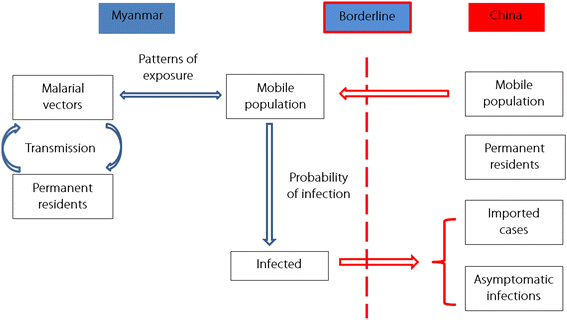Mobile population dynamics and malaria vulnerability: a modelling study in the China-Myanmar border region of Yunnan Province, China
- PMID: 29704895
- PMCID: PMC5924679
- DOI: 10.1186/s40249-018-0423-6
Mobile population dynamics and malaria vulnerability: a modelling study in the China-Myanmar border region of Yunnan Province, China
Abstract
Background: The China-Myanmar border region presents a great challenge in malaria elimination in China, and it is essential to understand the relationship between malaria vulnerability and population mobility in this region.
Methods: A community-based, cross-sectional survey was performed in five villages of Yingjiang county during September 2016. Finger-prick blood samples were obtained to identify asymptomatic infections, and imported cases were identified in each village (between January 2013 and September 2016). A stochastic simulation model (SSM) was used to test the relationship between population mobility and malaria vulnerability, according to the mechanisms of malaria importation.
Results: Thirty-two imported cases were identified in the five villages, with a 4-year average of 1 case/year (range: 0-5 cases/year). No parasites were detected in the 353 blood samples from 2016. The median density of malaria vulnerability was 0.012 (range: 0.000-0.033). The average proportion of mobile members of the study population was 32.56% (range: 28.38-71.95%). Most mobile individuals lived indoors at night with mosquito protection. The SSM model fit the investigated data (χ2 = 0.487, P = 0.485). The average probability of infection in the members of the population that moved to Myanmar was 0.011 (range: 0.0048-0.1585). The values for simulated vulnerability increased with greater population mobility in each village.
Conclusions: A high proportion of population mobility was associated with greater malaria vulnerability in the China-Myanmar border region. Mobile population-specific measures should be used to decrease the risk of malaria re-establishment in China.
Keywords: Importation; Individual-based model; Malaria; Mobile population; Vulnerability.
Conflict of interest statement
Ethics approval and consent to participate
The study was reviewed and approved by the ethical committee of the National Institute of Parasitic Diseases, Chinese Centre for Disease Control and Prevention.
Competing interests
The authors declare that they have no competing interests.
Figures




References
MeSH terms
Grants and funding
LinkOut - more resources
Full Text Sources
Other Literature Sources
Medical

